Posted by Richard_Farber on 12-03-2003 10:15 AM:
Moroccan(?) flat weave and knotted - carpet
Dear Turkotekaroos,


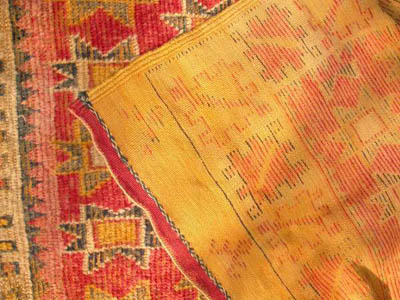
This piece seems to have been woven as a kilim of one color
(with some changes in the color according to the batch of the wool) than later
knots were added in two shades of red, two of blue-green, orange, tan and brown
to form the design. Kind of reminds me of a julkir.
I am rather sure that
the colors are natural (?).
1. because of the way the wool reflects
light.
2. because the of the way the color is constant through the entire
strand and back with no tip fading, and
3. because I washed the piece and
there was no color run.
I know next to nothing about North African
carpets and would appreciate some help in an attribution.
Sincerely
Richard Farber
thanks to Izhak Mordekhai for
the digital images.
Posted by Filiberto Boncompagni on 12-03-2003 10:33 AM:
Hi Richard,
You say "This piece seems to have been woven as a kilim of
one color… than later knots were added".
Well, I don’t think that this is
possible.
Perhaps this is a knotting on warp-faced ground, like Central
Asian tent bands. That’s what it looks like in your third
picture.
Regards,
Filiberto
Posted by Filiberto Boncompagni on 12-03-2003 10:58 AM:
Correction: from Hali # 94, "Moroccan Carpets" page 78
High Atlas
Carpets
…Produced in the mountainous region of Djebel Siroua,
where the pre-desert climate is much more drier the that of the Middle Atlas,
these carpets are made from a long-staple wool as silky and lustrous as he best
Middle Eastern wool. This material quality is further emphasized by the high
number of weft, usually at least ten, between each row of knots. Thus these
carpets are more like flatwoven cloths decorated with knotted
tufts…
....
This region was close, in the old days, to the
indigo-dyeing areas and areas where numerous plants producing yellow dyes were
available. The resulting palettes consists of very light colours with various
shades of yellow, blue, turquoise and green of a rare quality.
Hope
it helps.
Regards,
Filiberto
Posted by Richard Farber on 12-03-2003 02:37 PM:
Dear Turkotickers,
Filiberto, thank you.
There was a
considerable immigration to Israel in 1949 and the early fifties from Morocco
including Jews from very remote regions of the Atlas Mountains.
In would
not be inconceivable that these new immigrants would be bringing their
belongings - including their carpets with them.
Would much appreciate
further input from those with access to images of these kinds of
carpets.
I can honestly say that I dont recoginze the
design.
Sincerely
Richard Farber
Posted by David R.E. Hunt on 12-03-2003 05:29 PM:
Moroccan Carpets
Greetings Fellow Turkotekkers- It was not long ago that right here on Salon 101
Discussion we delved into this subject - I think you will find the
discussions of interest. Moroccan carpets with natural dyes are rather uncommon,
it is my understanding, the vast majority being otherwise. I like your rug
Richard, looks like much of the High Atlas weaving I have seen- Dave
Posted by R. John Howe on 12-03-2003 07:00 PM:
Hi Richard -
There have been a few books on Moroccan rugs and textiles
recently.
My near neighbor here in Washington, Russell Pickering, was,
with his daughter Brooke and his friend Ralph Yohe, one of those who wrote
first. There's a second book on one of their Moroccan collections and I think
they recently announced that they are selling it.
Marla Mallett is one of
those, respected among ruggies, who is not embarrassed to be interested in
Moroccan rugs and textiles and her site often has such items.
And, as I
mentioned in one thread in Salon 101, that David cites, the exhibition of pieces
from the Indianapolis museum is traveling and just left the African gallery of
the Smithsonian recently. There is a full color catalog of that exhibition
available too.
Many collectors disdain Moroccan rugs and weaving because
they tend to be crudely done (although Marla argues complex weaves are sometimes
used) and they are nowadays full of synthetic dyes. But folks like those cited
above and even Wilfred Stanzer, recently head of ICOC, find them very
interesting.
I could put up quite a few images if you cite an area of
interest.
Regards,
R. John Howe
Posted by Marla Mallett on 12-03-2003 09:44 PM:
Hi Richard and all,
These weavings are most often just labeled
“Ouaouzguite,” from the High Atlas Mountains in southeastern Morocco. They are
weft-faced weaves, with widely separated rows of long knotted pile that nearly
lies flat, exhibiting the glossy wool to best advantage—at least when in “full
pile” condition. Nothing is added “afterwards,” but rather several picks of weft
are woven, then a row of knots is tied. Anyone who complains because they are
“coarse” is missing the point; they are entirely different animals from Asian
carpets. Most do not exhibit natural dyes, but can be extremely handsome pieces
nevertheless. I like yours.
Best wishes,
Marla
Posted by R. John Howe on 12-04-2003 05:56 AM:
Marla -
Say a little more about folks who might "miss the point" of
Moroccan weaving.
It's not just that they're "coarse" (lots of the
wonderful Turkish village rugs do not rise above 25 knots per square inch in
their fineness; Wendel Swan owns something that has one knot per square inch),
but the Moroccan pile pieces often seem to be woven loosely and can contain so
many irregularities that they would often seem to qualify for the simply "bad
weaving" category.
Why do they not,
necessarily?
Regards,
R. John Howe
Posted by Marla Mallett on 12-04-2003 10:59 PM:
Hi John, Richard and all,
All “Moroccan pile pieces” are not the
same, and because some are carelessly constructed, we need not condemn them all.
I find huge differences between some of the Rabat “city” carpets, for example,
and Berber pieces such as those from the High Atlas Mountains. The Rabat
carpets, which often display Turkish or Persian motifs, can seem crude, with
insensitive color usage, and a design/weave scale that is out of proportion. Few
of those appeal to me, and over the several years in which I dealt in Moroccan
pieces, I never could convince myself to buy one.
We should perhaps
consider whether or not we should even call the majority of High Atlas
Ouaouzguite pile weavings “carpets,” as they are closer to blankets in their
handle. They are soft, flexible, multi-purpose weavings. The patterns and their
scale, for the most part, tend to be quite well suited to the structure. And
while their pile is widely spaced, long, and shaggy, it’s not fair to merely
dismiss the best old examples as “coarse.” They can be at once bold and sensual
objects. There is, for example, a huge, long, (maybe 25 foot long?) shaggy black
piece in the museum in Fez that blows me away with its primal power. There’s
nothing from Western or Central Asia to which it could reasonably be compared.
It is a completely different kind of object.
I must admit that the
majority of Moroccan Berber pile rugs from the Middle Atlas—especially pieces
from the second half of the 20th century--I find extremely dull and
uninteresting. But not all. I think most of those can indeed be characterized as
“coarse.”
As for Moroccan flat weaves, the weft-substitution techniques
and designs used by Middle Atlas Berber nomads are extremely complex, as are the
elaborate examples of twining from the High Atlas. Old examples can be truly
amazing! We just don’t see many of these pieces around, so that most folks don’t
have an opportunity to make fair judgments about them. In my opinion, US
exhibitions held in the 80s and 90s included mostly mediocre pieces. In the
mid-1970s, when I was tracking down these things in Morocco, fabulous things
were turning up. Unfortunately, I didn’t have the wisdom to hang on to at least
a few of them, and the supply did not last long; thus I must admit that I lost
interest in the hunt.
These are of course purely personal views!
Best,
Marla
Posted by Phil Lloyd on 12-06-2003 03:55 PM:
Rehamna Rugs..
Like Marla,.I have always been wary of purchasing a genuine Tribal
type,.'Rehamna' or Boujad ' carpet from Morocco...
I LOVE their mellow colour
and abstract look,.but,.whenever I have handled one,.I shy away from getting my
cheque book out !
But,.no longer,.I have done the deed,.and you know what,.I
am glad that I did !..What a beautiful thing my Rehamna is,.
Please,..John
Howe,..do post some pictures of these crazy and fairly course,.lol..(very
course,lol.. )...,.but genuine weavings...
All the best,.Phil
Lloyd,.Hampshire,.UK...
Posted by Richard Farber on 12-06-2003 08:45 PM:
Dear Turkoteccans,
Yes, the carpet has the feel of soft blanket and I
too would appreciate seeing images of carpets with similar designs to
mine.
Thanks in advance,
Richard Farber
Posted by David R.E. Hunt on 12-07-2003 12:47 AM:
Natural Dye High Atlas Rug
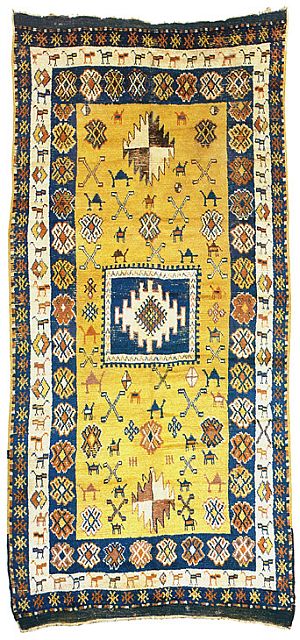
If I could
recall the source of this image I would credit him/her- but it escapes me- I
believe it was from an online auction catalogue - now expired, but none the less
we might want to refrain from speculation as to quality, value ect. It was
described as being from the last century and to be both of natural dye and good
quality- it looks strikingly like several I have seen offered for sale by
vendors in the High Atlas, but most of the latter had some rather obvious
chemical dyes. For myself, this design represents THE High Atlas rug-
Dave
Posted by R. John Howe on 12-07-2003 10:17 AM:
Dear folks -
Here are a few of the images of other versions of High
Atlas rugs. In the two books from which they are drawn they are mostly presented
with the long sides vertical. I have rotated those images here to the left so
that you can see the designs more clearly. The orientation does change the way
they look. If you can print them off, it might be worth doing do that you can
look at them in the orientation in which all but the first below was
printed.
The first three are from the Pickering, Pickering and Yohe, book
"Moroccan Carpets."
Here first is a 19th century rug of this sort. It is
18 feet long and four feet, seven inches wide. It is presented with a two page
layout. I have given you both halves in separate images here.
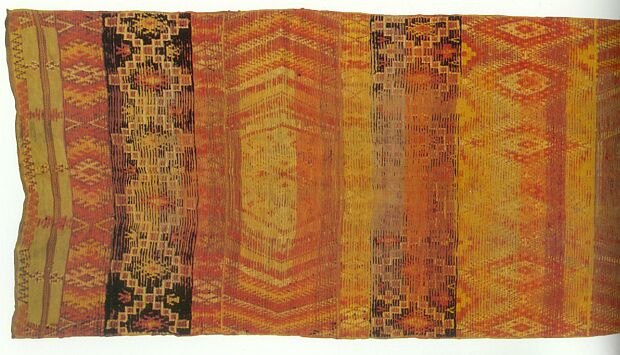
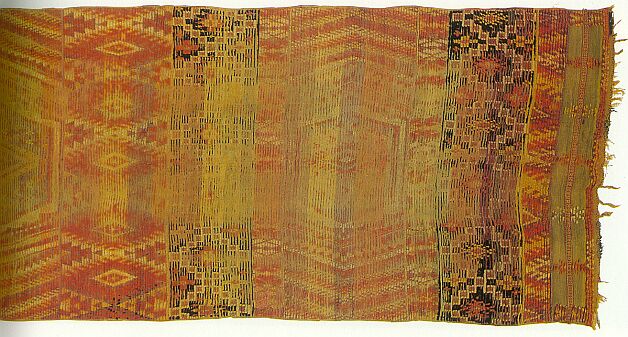
These piece are often very long.
Pickering, Pickering and Yohe present one that is 23 feet long.
Note that
this piece has no side borders. Borders apparently are an indicator of later
pieces.
The piece below is estimated at second quarter, 20th
century.

The
next one is about the same age and shorter, only a little over 7 feet
long.

The last
piece is from another book, "From the Far West: Moroccan Carpets and Textiles."
It was a jointly authored publication of The Textile Museum.
Some of
these pieces show a lot of white.
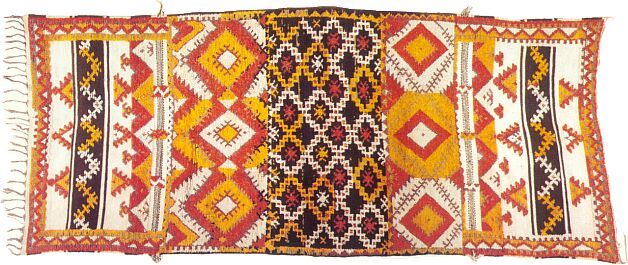
Regards,
R. John Howe
Posted by Phil Lloyd on 12-07-2003 03:24 PM:
The Plains of Marrakesh.
Many thanks for those splendid images John.
My own 'latest passion' is now
for the realy Tribal carpets woven by the Rehamna tribe and the strangely
abstract pieces referred to as 'Boujad'..I have read the modern works of the
Pickerings and also obtained a copy of the book,.'From Sign to Image' by
Abdelkebir Khatibi and Ali Amahan,..also on the subject of Moroccan
carpets,..however,.apart from a few pages of images and various splendid
articles in Hali,..the available photos of these unusual and quite striking
weavings would seem to be rather thin on the ground ( a bit like the rugs
themselves )...?
I personaly doubt if I will ever get over the sheer
'courseness' of weave and low knot count that gives these pieces their flimsy
,..blanket - like feel,..but as Marla has stated,..these creations must not be
viewed in the same light as other Middle Eastern rugs and carpets,.and slowly
but surely,.I'm getting there..lol...So,.do any of the Turkotek members have any
further images to post,.all info,.any info,.. gratefully recieved..
Many
thanks,.Phil Lloyd,.Hampshire,UK...
Posted by R. John Howe on 12-08-2003 06:45 AM:
Hi Phil -
Since you're interested in this area, it might be useful to
have the specifics on the Moroccan rug and textile exhibition, from the
Indianapolis Museum of Art, that is currently traveling in the U.S.
There
is a full-color catalog.
The Fabric of Moroccan Life (2002)
Niloo
Imami Paydar and Ivo Grammet, general editors
Hardcover $45.00
304
pages; 199 color illustrations
ISBN 0-936260-76-9
Distributed by
University of Washington Press.
This book accompanies the IMA exhibition
The Fabric of Moroccan Life—the largest exhibition of Moroccan art ever
presented in the United States. Featuring 150 textiles from the IMA collection,
the catalogue provides an overview of that collection and includes essays on
such topics as Moroccan embroidery and its origins, the traditional costumes of
the cities and rural areas, the weavings of the Berbers and other ethnic groups,
and the distinctive characteristics of items made by particular ethnic
sub-groups. The contributing writers are eminent scholars and experts in a
variety of fields, including Moroccan history and culture; Moroccan rugs,
textiles, and clothing; and natural dyes. The catalogue offers a wealth of
information on the subject that has never been available before in one
volume.
Here also is the link to the Indianapolis Museum book
store.
http://www.ima-art.org/publications.asp?SID=474176DFE25B4DFE8AFF5A2672EFA44B
The
materials seem stronger to me than those in some other collections. The
Indianapolis collection of Moroccan material came mostly from that of a single
couple who apparently collected quite early.
Regards,
R. John
Howe
Posted by David R.E. Hunt on 12-09-2003 09:23 PM:
Three Streams of Influence
Dear Phil and All- Iv'e scanned a photo of both

a Rehamna and A boujad, so
all can get an idea of what we are talking about.
It happens that I was
searching
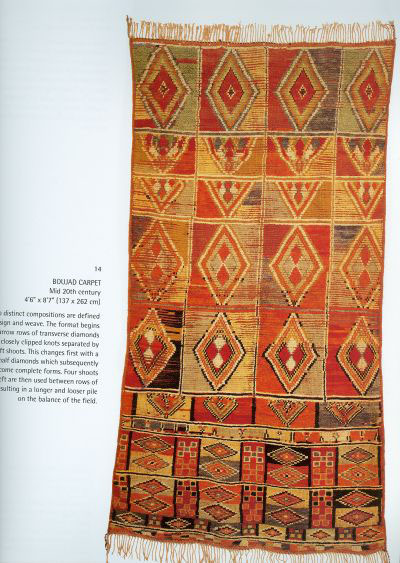
the web for a reference to the Oulad Bou Sbaa, who reside upon
the Marrakech plains, only to find rugs of strikingly simular design- to those
attribuited to the Rehemna by Pickering. This is not to call into question
Pickerings assertions as to provenance, as both could well produce simular
material, but as an indicator as to what degree those three primary influences
of Moroccan carpet designs, Turkic, Berber and Arab have affected design
repetoir.
Recalling both the archived discussion
15th Cent
Andalusian Rug
and the images of early 19th cent
city carpets
post by our moderator Filiberto in the forementioned
archived
Salon#101
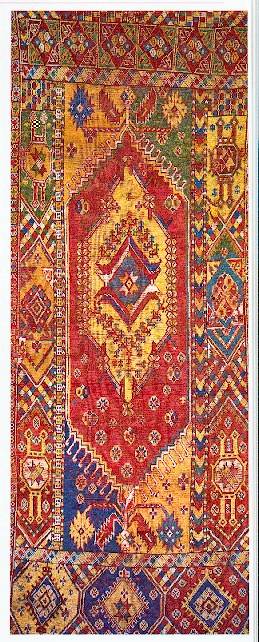
it's apparent that Turkic design has exerted much influence,
even as demonstrated by this

antique High Atlas weaving with its clearly defined(and wide)
borders and central medallion/symmetical composition.
Pickering asserts a
belief, and submits

this antique weaving, with it's design symmetry of horizontil
banding, as representing a most archaic or authentic berber design composition.
With it's three wider bands, the basic format is simular to this,
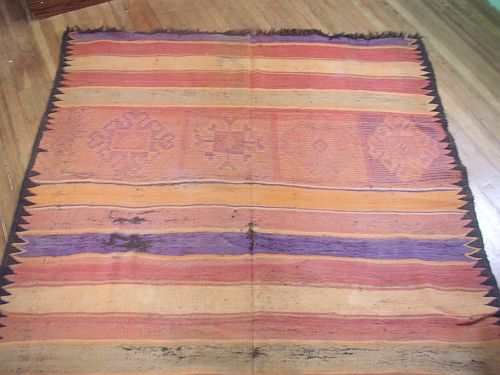
or possibly even
this
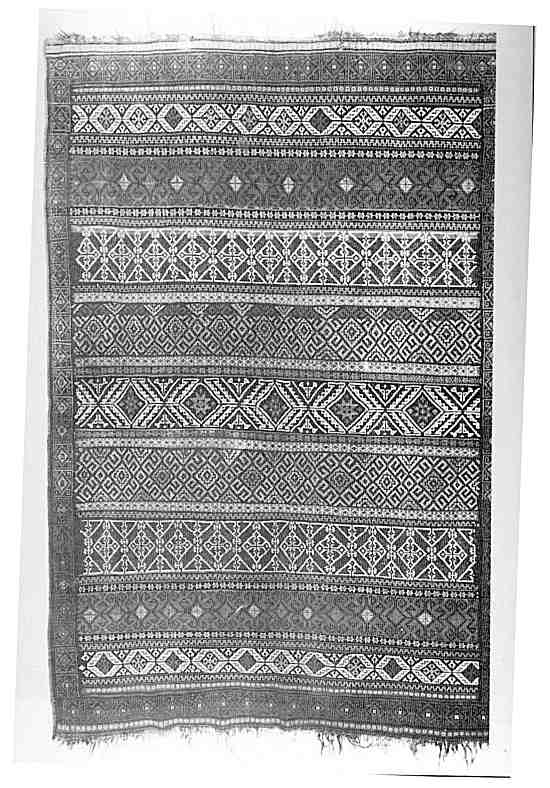
- It's
getting late, more tomorrow- Dave
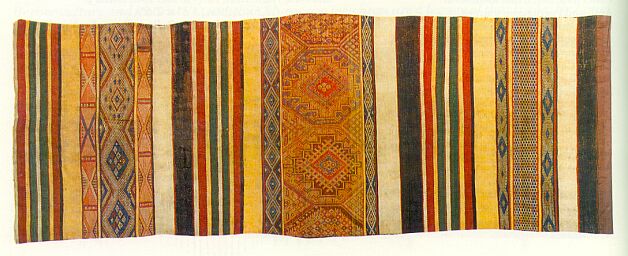
Another Moroccan example of this banded format
Posted by David R.E. Hunt on 12-10-2003 10:06 PM:
The Arabs
To All-The last of the three images being compared above from my last post,
Jenny Housego's Tribal Rugs plate#120, are described as being produced by Baluch
or Kerman tribes and hence middle eastern. While of course it could be argued
that the limitations of the weaving medium might themselves first suggest a
format of horizontil stripes, and that the design evolved independantly, the
appearence of this weft float technique, common as I understand only to these
areas say to me - Imported. And history does I believe bear witness to the fact
that the Arab invaders, proceeding from the Fatamids of Cairo to Syria, Libiya,
and in turn most the rest of North Africa- and may well have brought their
designs and techniques to these areas so long ago, which to this day they are
still to be found in modified form.
It seems that when we speak of Morocco we
seem to forget that while the indigenous peoples who have left an indellible
print and impart a discernable artistic sensibility or aesthetic to much of the
creative process, the Berber were and perhaps still are a subdjucated people.
Neither their language nor their religion, let alone the people themselves, are
the dominating forces in Morocco.
Posted by David R.E. Hunt on 12-12-2003 04:55 AM:
Berbers- Up Close and in Person
Everyone-
I owe
this woman an apology,as she is actually rather attractive, not a great picture
of her but a nice picture in general.
This photo was taken in her back yard
as she was doing some chores in this blinding light and heat- and she is a
berber. However, as with so many, she speaks Arabic. Granted, it is my
understanding that as a general rule the ethnologist uses language as a
delineating marker, but in Morocco many of the Berber speak Arabic. I don't know
that there is any danger of the language being extinguished, but it has been
supplanted to a considerable degree.
Who are these Berbers, these fair
complected Meditterainian
people who have resided in North Africa since the
advent of recorded history, whose language in it's written form is rarely
encountered?
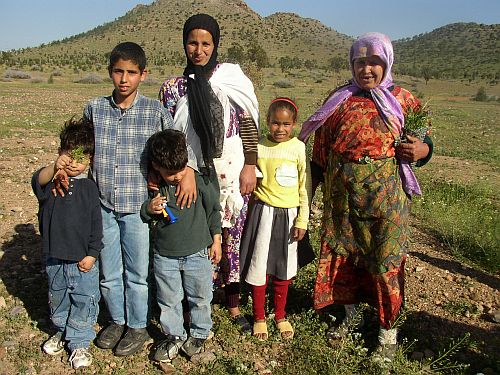
As we can see, they are a rather diverse group- with the
exception of the twins situated to the immediate left and right of the young man
depicted, these people are all berber. Such is the main obstacle to description
or categorization of the Berber people- and in turn their weaving. Note the
habit of the women wearing an apron over their dress- the height of polyester
tribal fashion. Looking into the background, we are afforded a glimpse of that
striking topography for which Morocco is so famous.This photo was taken at the
foot of the High Atlas mountains,hence what we see in the background of the
photo are- the foothills of the High Atlas. Those thin horizontil lines
circumventing these hills and appearing in the photo as striations are the
remnants of terraced gardens or pastureland, now abandoned. A couple of hundred
years ago this region was temperate. This photo was taken in the spring, but by
summer most all the green you see will have withered, the little moisture
available driven off by the heat.
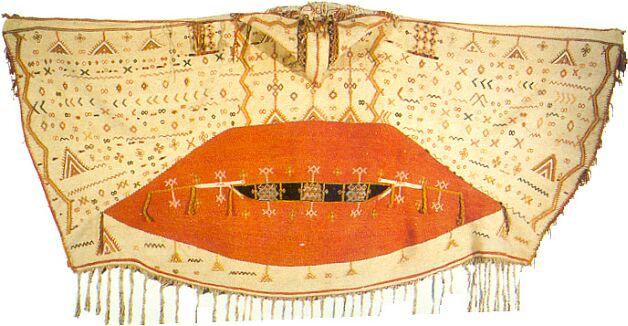
Posted by Richard Farber on 12-12-2003 06:07 AM:
Dear turkoberbers,
Mr. Hunt . . . you have been posting wonderful
images . .. perhaps you might do a essay on the populations of North Africa and
a little background on the styles of carpets . . .in other words do a proper
salon . . . you seem to be well informed and most interested . . . PLEASE . . .
We could take this thread and include it in the discussion of the salon
if that would be o.k. with Steve and Filiberto.
Thanks
again.
Sincerely
Richard Farber
Posted by David R.E. Hunt on 12-12-2003 11:08 PM:
I'm Flattered Really...
Richard and All- I don't know what happened, but suddenly the muse was upon
me. I'm afraid that I don't know enough about the people of North Africa to work
up something of interest on such a broad topic, but I think I would enjoy
continuing this line of inquiry, that of the origin of Moroccan carpet designs,
in salon form. Rest assured I am not a professional, formal experience
constituting no more than a couple of anthropology classes, a little time
spent in the region, a keen interest in carpets, and being married to a
moroccan. I'll see what I can come up with-Dave
Posted by Filiberto Boncompagni on 12-13-2003 08:52 AM:
Please go ahead, Dave, new Salons are always welcomed.
Besides, you
are in a very good position for writing on Moroccan textiles.
Best
regards,
Filiberto


















